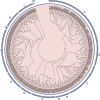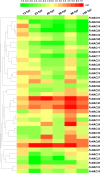Genome-wide identification and expression profile analysis of the NAC transcription factor family during abiotic and biotic stress in woodland strawberry
- PMID: 29897926
- PMCID: PMC5999216
- DOI: 10.1371/journal.pone.0197892
Genome-wide identification and expression profile analysis of the NAC transcription factor family during abiotic and biotic stress in woodland strawberry
Abstract
The NAC transcription factors involved plant development and response to various stress stimuli. However, little information is available concerning the NAC family in the woodland strawberry. Herein, 37 NAC genes were identified from the woodland strawberry genome and were classified into 13 groups based on phylogenetic analysis. And further analyses of gene structure and conserved motifs showed closer relationship of them in every subgroup. Quantitative real-time PCR evaluation different tissues revealed distinct spatial expression profiles of the FvNAC genes. The comprehensive expression of FvNAC genes revealed under abiotic stress (cold, heat, drought, salt), signal molecule treatments (H2O2, ABA, melatonin, rapamycin), biotic stress (Colletotrichum gloeosporioides and Ralstonia solanacearum). Expression profiles derived from quantitative real-time PCR suggested that 5 FvNAC genes responded dramatically to the various abiotic and biotic stresses, indicating their contribution to abiotic and biotic stresses resistance in woodland strawberry. Interestingly, FvNAC genes showed greater extent responded to the cold treatment than other abiotic stress, and H2O2 exhibited a greater response than ABA, melatonin, and rapamycin. For biotic stresses, 3 FvNAC genes were up-regulated during infection with C. gloeosporioides, while 6 FvNAC genes were down-regulated during infection with R. solanacearum. In conclusion, this study identified candidate FvNAC genes to be used for the genetic improvement of abiotic and biotic stress tolerance in woodland strawberry.
Conflict of interest statement
The authors have declared that no competing interests exist.
Figures













Similar articles
-
The WRKY transcription factors in the diploid woodland strawberry Fragaria vesca: Identification and expression analysis under biotic and abiotic stresses.Plant Physiol Biochem. 2016 Aug;105:129-144. doi: 10.1016/j.plaphy.2016.04.014. Epub 2016 Apr 11. Plant Physiol Biochem. 2016. PMID: 27105420
-
Identification and Expression Analysis of GRAS Transcription Factors to Elucidate Candidate Genes Related to Stolons, Fruit Ripening and Abiotic Stresses in Woodland Strawberry (Fragaria vesca).Int J Mol Sci. 2019 Sep 17;20(18):4593. doi: 10.3390/ijms20184593. Int J Mol Sci. 2019. PMID: 31533278 Free PMC article.
-
Identification, isolation, and expression analysis of heat shock transcription factors in the diploid woodland strawberry Fragaria vesca.Front Plant Sci. 2015 Sep 15;6:736. doi: 10.3389/fpls.2015.00736. eCollection 2015. Front Plant Sci. 2015. PMID: 26442049 Free PMC article.
-
Genome-wide identification and comprehensive analysis of the NAC transcription factor family in Sesamum indicum.PLoS One. 2018 Jun 21;13(6):e0199262. doi: 10.1371/journal.pone.0199262. eCollection 2018. PLoS One. 2018. PMID: 29927997 Free PMC article.
-
Genome-Wide Identification and Abiotic Stress Response Analysis of PP2C Gene Family in Woodland and Pineapple Strawberries.Int J Mol Sci. 2023 Feb 17;24(4):4049. doi: 10.3390/ijms24044049. Int J Mol Sci. 2023. PMID: 36835472 Free PMC article.
Cited by
-
Overexpression of the Tectona grandis TgNAC01 regulates growth, leaf senescence and confer salt stress tolerance in transgenic tobacco plants.PeerJ. 2022 Mar 3;10:e13039. doi: 10.7717/peerj.13039. eCollection 2022. PeerJ. 2022. PMID: 35261823 Free PMC article.
-
Genome-wide identification and expression analysis of the NAC transcription factor family in tomato (Solanum lycopersicum) during aluminum stress.BMC Genomics. 2020 Apr 7;21(1):288. doi: 10.1186/s12864-020-6689-7. BMC Genomics. 2020. PMID: 32264854 Free PMC article.
-
Genome-wide identification and expression profiling reveal the regulatory role of U-box E3 ubiquitin ligase genes in strawberry fruit ripening and abiotic stresses resistance.Front Plant Sci. 2023 Mar 23;14:1171056. doi: 10.3389/fpls.2023.1171056. eCollection 2023. Front Plant Sci. 2023. PMID: 37035055 Free PMC article.
-
Genome-Wide Identification, Characterization, and Expression Analysis of the NAC Transcription Factor in Chenopodium quinoa.Genes (Basel). 2019 Jun 30;10(7):500. doi: 10.3390/genes10070500. Genes (Basel). 2019. PMID: 31262002 Free PMC article.
-
LcNAC13 Is Involved in the Reactive Oxygen Species-Dependent Senescence of the Rudimentary Leaves in Litchi chinensis.Front Plant Sci. 2022 May 9;13:886131. doi: 10.3389/fpls.2022.886131. eCollection 2022. Front Plant Sci. 2022. PMID: 35615126 Free PMC article.
References
-
- Souer E. The no apical meristem gene of petunia is required for pattern formation in embryos and flowers and is expressed at meristem and primordia boundaries. Cell.1996; 85:159 - PubMed
-
- Aida M, Ishida T, Fukaki H, Fujisawa H, Tasaka M. Genes involved in organ separation in Arabidopsis: an analysis of the cup-shaped cotyledon mutant. Plant Cell. 1997; 9:841–857. doi: 10.1105/tpc.9.6.841 - DOI - PMC - PubMed
-
- Kikuchi K, Uequchi-Tanaka M, Yoshida KT, Nagato Y, Matausoka M, Hirano HY. Molecular analysis of the NAC gene family in rice. Mol Genet Genomics. 2000; 262:1047–1051. - PubMed
-
- Ooka H, Satoh K, Doi K, Nagata T, Otomo Y, Murakami K, et al. Comprehensive analysis of NAC family genes in Oryza sativa and Arabidopsis thaliana. DNA Res. 2013; 10:239–247. - PubMed
Publication types
MeSH terms
Substances
LinkOut - more resources
Full Text Sources
Other Literature Sources

